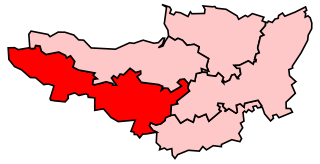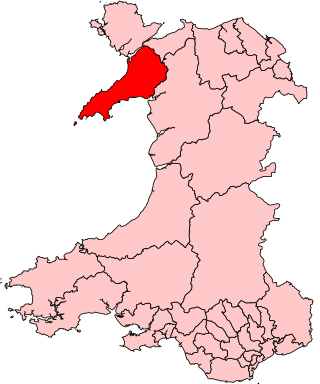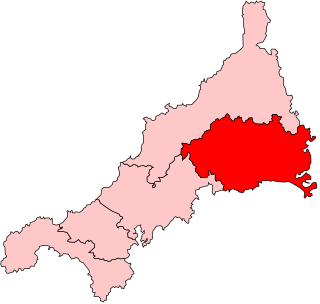
Taunton was a constituency represented in the House of Commons of the Parliament of the United Kingdom and its predecessors from 1295 to 2010, taking its name from the town of Taunton in Somerset. Until 1918, it was a parliamentary borough, electing two Member of Parliaments (MPs) between 1295 and 1885 and one from 1885 to 1918; the name was then transferred to a county constituency, electing one MP.

Caernarfon was a parliamentary constituency centred on the town of Caernarfon in Wales. It elected one Member of Parliament (MP) by the first past the post system.

Harwich was a parliamentary constituency represented in the House of Commons of the Parliament of the United Kingdom. Until its abolition for the 2010 general election it elected one Member of Parliament (MP) by the first past the post system of election.
Forfarshire was a Scottish county constituency represented in the House of Commons of Great Britain from 1708 until 1800, and then in the House of Commons of the United Kingdom until 1950.
Grantham was a Parliamentary constituency in Lincolnshire, England.
Montgomery was a constituency in the House of Commons of England and later in the House of Commons of the Parliament of the United Kingdom. It elected one Member, but was abolished in 1918.
Eye was a parliamentary constituency, represented in the House of Commons of the Parliament of the United Kingdom, encompassing an area around the market town and civil parish of Eye, Suffolk.
Derby is a former United Kingdom Parliamentary constituency. It was a constituency of the House of Commons of the Parliament of England, then of the Parliament of Great Britain from 1707 to 1800 and of the Parliament of the United Kingdom from 1801 to 1950. It was represented by two members of parliament. It was divided into the single-member constituencies of Derby North and Derby South in 1950.
Shrewsbury was a parliamentary constituency in England, centred on the town of Shrewsbury in Shropshire.

Tiverton was a constituency located in Tiverton in east Devon, formerly represented in the House of Commons of the Parliament of the United Kingdom. Enfranchised as a parliamentary borough in 1615 and first represented in 1621, it elected two Members of Parliament (MPs) by the first past the post system of election until 1885. The name was then transferred to a county constituency electing one MP.
Flintshire was a parliamentary constituency in North-East Wales which generally returned one Member of Parliament (MP) to the House of Commons, latterly that of the Parliament of the United Kingdom, from 1542 until it was abolished for the 1950 general election.

Bodmin was the name of a parliamentary constituency in Cornwall from 1295 until 1983. Initially, it was a parliamentary borough, which returned two Members of Parliament to the House of Commons of England and later the House of Commons of the Parliament of the United Kingdom until the 1868 general election, when its representation was reduced to one member.
Pembrokeshire was a parliamentary constituency based on the county of Pembrokeshire in Wales. It returned one Member of Parliament (MP) to the House of Commons of the Parliament of the United Kingdom, elected by the first past the post system.
Hastings was a parliamentary constituency in Sussex. It returned two Members of Parliament to the House of Commons of the Parliament of the United Kingdom until the 1885 general election, when its representation was reduced to one member. It was abolished for the 1983 general election, when it was partially replaced by the new Hastings and Rye constituency.
Hertford was the name of a parliamentary constituency in Hertfordshire, which elected Members of Parliament (MPs) from 1298 until 1974.

Barnstaple was a constituency centred on the town of Barnstaple in Devon, in the South West of England. It returned two Members of Parliament to the House of Commons of the Parliament of the United Kingdom until 1885, thereafter, one.
Merioneth, sometimes called Merionethshire, was a constituency in North Wales established in 1542, which returned one Member of Parliament (MP) to the House of Commons of the English Parliament, and later to the Parliament of Great Britain and of the United Kingdom. It was abolished for the 1983 general election, when it was largely replaced by the new constituency of Meirionnydd Nant Conwy.
Evesham was a parliamentary constituency in Worcestershire which was represented in the British House of Commons. Originally a parliamentary borough consisting of the town of Evesham, it was first represented in 1295. After this its franchise lapsed for several centuries, but it then returned two Members of Parliament (MPs) from 1604 until 1868, when its representation was reduced to one member under the Representation of the People Act 1867.
Dudley was a parliamentary constituency centred on the town of Dudley in Worcestershire.
The 1880 Caernarvonshire by-election was a parliamentary by-election held for the House of Commons constituency of Caernarvonshire in Wales on 2 December 1880.
This page is based on this
Wikipedia article Text is available under the
CC BY-SA 4.0 license; additional terms may apply.
Images, videos and audio are available under their respective licenses.





